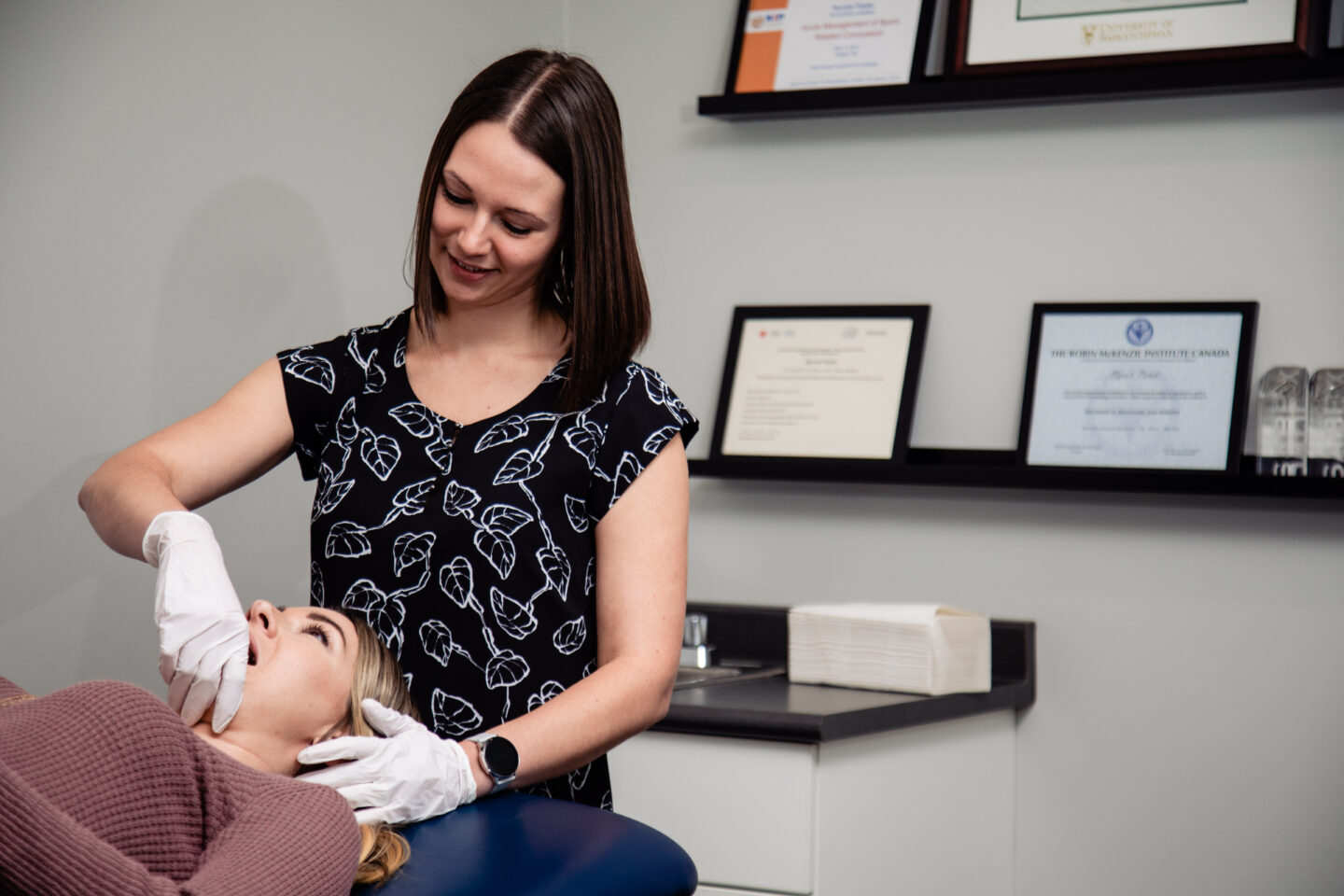How A Physiotherapist Approaches Headache Treatment
Assess the Source of the Headaches
The first step in the treatment of headaches from a physiotherapy view is to determine what is causing your headaches. There are many causes for a headache, but chronic headaches can often begin because of issues in the neck or jaw (TMJ) area. We will therefore examine your neck and jaw to discover if there are problems in these areas, and if so suggest helpful treatments to relieve your pain. If we think that further investigation is needed we will contact your family physician.
Suggested Treatments
Exercises
One possible treatment is to perform special exercises each day or several times a day. We will teach you how to perform these movements and give you a schedule to follow.
Hands-on Mobilization
We may determine there is stiffness and a need to mobilize the tissues in your neck or jaw. This is a hands-on treatment where we can help the joints and tissues around your neck and jaw move better.
Massage
Sometimes massage from a physiotherapist is what is needed to relax certain sensitive areas in the neck and jaw that can contribute to headaches. Our team understands how to find the right areas and apply a specific amount of pressure to address this issue.
Relaxation Therapy
We may also suggest relaxation techniques that can help control headaches and the conditions that cause them.
Suggested Prevention Strategies
Work Posture
The way you hold or move your body while you work could be contributing to your headaches. This is a very common source of headaches and one of our team physiotherapists can give you strategies to improve your posture while looking at a screen or siting at a work desk. We will also teach you techniques for taking breaks during work to stand and stretch. To review a brief video about basic principles for setting up your office workspace click here.
Sleeping Posture
The way you position your body during sleep can also cause headaches and pain. We will show you the proper way to sleep in order to keep headaches away. To review a brief video about some initial strategies to address your sleeping posture click here.
Everyday Movement
The way you sit, stand, and walk can all have an impact on how your body feels. When you move your muscles in certain ways, headaches can be the result. We will teach you the right way of moving your body or how to align yourself to move better in order to avoid pain and headaches.
Reasons for Headaches and Migraines
Stiff Joints in the Neck or Jaw
Stiffness in the neck and jaw are common causes of headaches. When the joints are stiff, it can trigger pain signals in the nervous system that lead to a headache.
Poor Posture
Sitting, standing, or even sleeping with improper posture can cause the body to react with pain. It is important that you keep your body properly aligned as much as possible to avoid painful consequences.
Sensitive or Tight Neck or Jaw Tissue
The tissues in the neck and jaw can become tight or even sensitive to touch and movement. The body often responds to this with pain in the head or even the face.
Stress
Emotional stress is very common. Emotional stress can create a chemical reaction that makes our nervous system more sensitive and also cause muscles to become tense. This can cause physical pain in the body that can often manifest as a headache. Stress can also cause us to clench more resulting in facial pain that many call TMJ (temporomandibular joint) or TMD (temporomandibular disorder). For further information about TMJ click here.
Migraines
Migraines are a specific type of headache that some people are more susceptible to than others. It is unclear exactly what causes migraines, but is probably a combination of factors. These can include genetics, a chemical imbalance in the brain, and mental health factors. Migraines may also be caused by hormonal changes and women may have them more often during certain times in the menstrual cycle. Vision, sound, and smell stimulus, along with stress, dietary choices and poor sleep can also be triggers. Some individuals also experience dizziness with migraines and our team of physiotherapists can provide strategies to manage headaches and associated dizziness.
Concussions
Concussions are typically the result of a strong blow to the head, and headaches are one of the most common initial and ongoing symptom. The headaches may even continue after the concussion itself has resolved. Most commonly this is due to the neck not fully being rehabbed. Remember, what attaches your head to your body? Your neck, so if your head was hit it is also likely that you strained your neck. If headaches persist after a concussion, best to have your neck assessed and treated.
A Combination of Issues
Headaches, especially chronic headaches, often come from a combination of conditions. Many headache triggers can lead to other problems that cause even more headaches or keep headaches from being resolved. A physiotherapist can help unravel this complicated web of headache triggers to get to the root cause so that the headaches can be properly treated.
Exercises for Headaches and Migraines
Neck Exercises
Shoulder Rolls
Lift your shoulders toward your ears. Roll them forward and all of the way around six times. Repeat this movement in the other direction.
Side Rotation
While maintaining good posture, turn your head slowly to one side. Stop when you feel a stretch. Hold the stretch for 10-15 seconds. Repeat this on the other side. Do 3 sets of this at least 3x/day.
Chin Tucks
While sitting upright try to bring your head back and make a double chin. This is a very effective exercise for headaches coming from the neck, but can be difficult to do initially as it takes some coordination. Feel free to book an appointment with one of our team physiotherapists to review this and any other exercises that may be beneficial for your headaches. Hold for 10-15 seconds. Repeat this on the other side. Do 3 sets of this at least 3x/day.
Shoulder Tilt
Stand with proper posture. Slowly tilt your head toward one shoulder as if you are going to touch it to your ear. Do not lift your shoulder. Keep all of the movement in your neck. Stop when you feel a stretch. Hold for 10-15 seconds. Repeat this on the other side. Do 3 sets of this at least 3x/day.
Strategies for Avoiding Headaches and Migraines
Keep a Journal
Keeping a headache journal can help you identify and avoid potential headache triggers and can help us identify the reasons for your headache. Write down what you ate, your activities, or even how you felt just before the headache began. Also, note the duration of the headache. Try to describe the pain and identify where on your head the pain occurs.
Eat Frequently
Skipping meals can sometimes cause a headache. Make sure you are eating regularly. If you are trying an intermittent fasting diet, this may be triggering headaches.
Regulate Your Sleep
Getting enough sleep is an important part of staying healthy, and a lack of sleep can be a cause of headaches. Try to keep a regular sleep pattern if at all possible to help your body avoid headaches.
Exercise
Moving your body regularly can reduce its tendency to get tight or stiff. This will help you avoid headaches. Exercise does not need to be strenuous. Even a 20 minute walk can help. Exercise not only keeps us moving physically, but also helps the body release endorphins that make our nervous system more relaxed. Other things that release endorphins are music, sex, and comedy.
Headaches can cause a lot of problems in your life including an inability to enjoy activities you like. You may also find that you are missing work because of your headaches. If headaches are a problem for you, contact us at North 49 Physical Therapy. Our team can help you understand what is causing your headaches, suggest strategies or treatments for relief, and determine if further investigation is needed. You don’t have to live with headaches. Call us today and let us help you.





